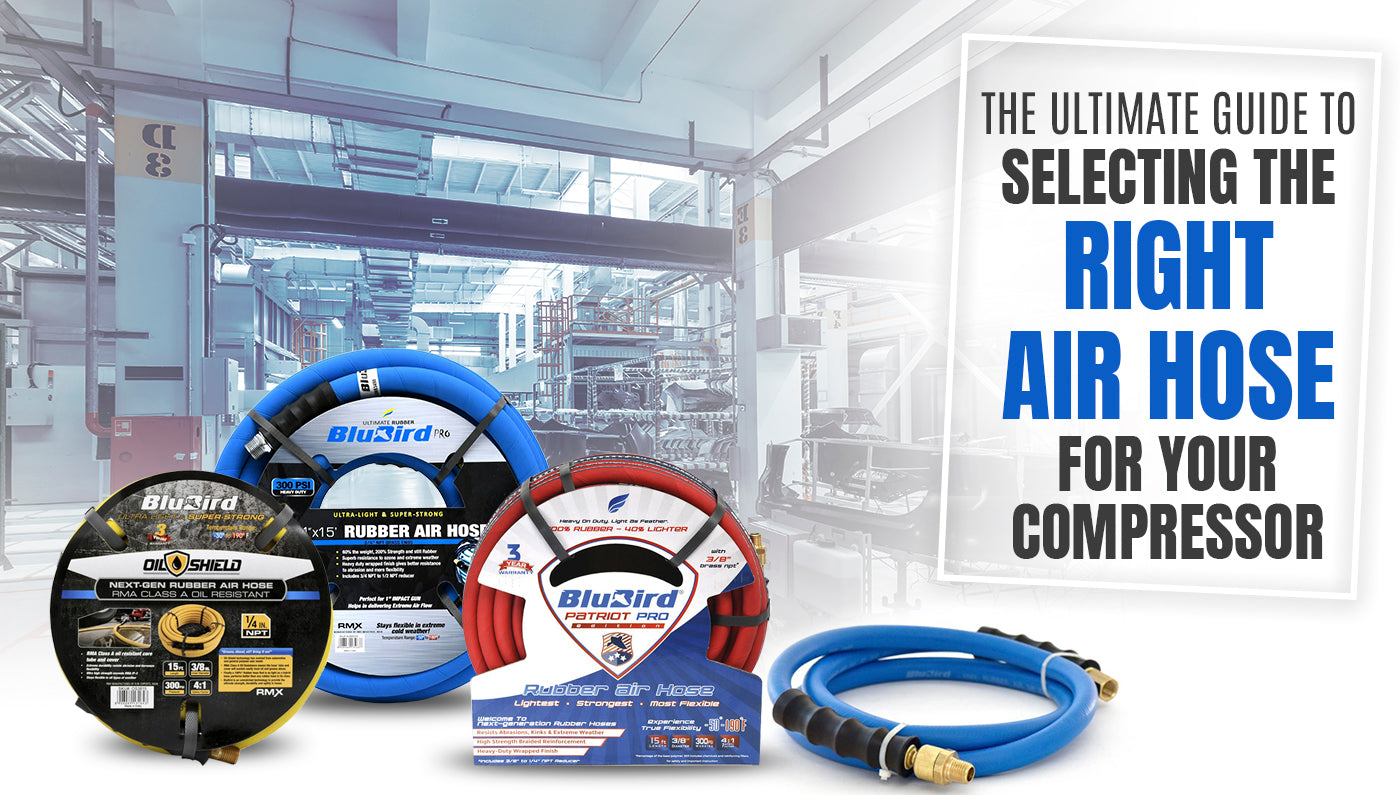You may think that buying the right air hose for your air compressor is a simple process, right? Well, although it may be simple, you need to consider a few important things before you buy to ensure you get the correct hose for your compressor. This will make sure you have a seamless experience with your air compressor and get your pressure tools working correctly and efficiently.
So, read on as we discuss a complete guide to help you select the correct air hose for your compressor.
Understanding Air Hoses
Before we begin to discuss how to choose the right air pressure hose, let’s first dive into the basics and understand what an air pressure hose is.
Air hoses are flexible tubes that are specially designed to transport air from your air compressor device to your air tool or any other device that works with compressed air.
Without an air hose, your air pressure tool will be rendered useless.
Factors to Consider While Choosing an Air Hose For Your Air Compressor
Now, let's look at some factors that you should consider before buying an air hose.
1. Material
The material of your air hose will influence the various applications you use it for, its longevity, and ease of use.
Two main materials are used for manufacturing air hoses – PVC and Rubber.
PVC Air Hose
PVC air hoses are made of a synthetic polymer of plastic and make for a great general-purpose air hose. PVC air hoses are also lightweight and cheap and are also resistant to chemicals, weather conditions, and hydrolysis.
Rubber Air Hose
This is the most common type of air hose material that is available in the market. This is because rubber air hoses are durable, kink-resistant, lightweight, and also suitable for professional air compressor tools.
2. Diameter
When you are selecting an air hose, you should always check out both its inner and outer diameter. You will find the measurements listed in the product box. The diameter of your air hose will play a crucial role in determining your air pressure and compatibility with the pressure tools you use.
The general rule is that the correct diameter of your air hose will depend on the CFM (cubic feet per minute) requirement of your air pressure tool.
For example, small hand-held air pressure tools like spray and nail guns will require around 1 and 3 CFM of pressurized air. So, for this pressure, around 6 mm diameter or ¼ inch air pressure hose will be required.
3. Length
The length of your air hose will depend on the type of operation you buy it for. For example, if you have a paint job to carry out, you will need a long air hose to accommodate the various range of movements you need to make.
However, if you use your pressure hose with a roofing nail gun, you will be sitting in one place and, thus, won't require a long hose.
Moreover, the length of your air hose will depend on the amount of pressure you get in your tool. A longer air hose will lead to a drop in pressure, while a shorter air hose will lead to an increase in pressure.
4. Flexibility
The flexibility of an air hose is crucial in ensuring efficient operations, ease of use, and longevity. Try to choose an air hose that is flexible enough to be manipulated and maneuvered without kinking or cracking. In this way, you won't have to worry about your air hose getting damaged when you need to navigate tight spaces or make sharp turns.
Air Hose Materials
The most common air hose materials are rubber, PVC, and hybrid blends. Let’s discuss these materials in more detail.
1. Rubber

Rubber hoses are known for their robustness and can withstand a wide range of temperatures and pressures. They are more flexible and versatile than PVC hoses. Thus, they can be used in various environments, including industrial settings, construction sites, and automotive applications.
2. PVC
PVC hoses are generally lightweight and less expensive but may not be as durable as rubber hoses. They can be prone to kinking and cracking over time, especially in extreme temperatures. These hoses are suitable for light to medium-duty applications. They are often used in gardening, household tasks, and some industrial applications where flexibility is more critical than durability.
3. Hybrid blends
Hybrid blends combine the properties of different materials for enhanced performance and are often used in automotive, pneumatic, and robotic applications. They are suitable for both indoor and outdoor use and can withstand various environmental conditions.
Sizing Your Air Hose
Selecting the correct hose fitting size is crucial for ensuring a secure connection and optimal performance. Below is a step-by-step guide to follow to ensure you choose the right hose fitting size.
1. Identify your hose type
Before measuring, determine the type of hose you're working with, such as hydraulic, pneumatic, or garden hose, as this will influence the fitting size and type.
2. Measure the Inner Diameter
Use a caliper or a hose inside diameter (ID) tape measure to measure the inner diameter.
3. Determine the thread type and size
For threaded fittings, you need to identify the thread type (e.g., NPT, BSP) and size (e.g., 1/4", 3/8", 1/2").
4. Consider the Application and Pressure Rating
Ensure that the fitting size and type are suitable for the intended application. Moreover, consider factors like temperature, pressure ratings and airflow requirements.
5. Test the fitting
Before finalizing your selection, test the fitting on the hose and the connection point, which may be the hose adapter or coupling.
Determining the Right Length
The ideal length for an air hose depends on specific needs and tasks. For small spaces and tasks that don’t require much movement, you can consider going for a shorter hose, which can be anything between 25-50 feet.
In contrast, larger areas may necessitate a longer hose (e.g., 50-100 feet) for extended reach. However, longer hoses can lead to pressure drops as the air has to travel a longer distance and storage challenges. Therefore, it's crucial to balance reach with practicality.
Maintenance and Care Tips
Proper care and maintenance of your air hose is crucial to ensure it lasts long and continues to perform efficiently and optimally for years to come.
Check out some of the maintenance and care tips listed below.
1. Regular inspection
Routinely check the entire length of the air hose for any signs of wear, cuts, or damage. Addressing minor issues early can prevent further damage and potential failures.
2. Cleaning your hose
Keep the hose clean by wiping it down after each use, especially if exposed to dirt, grease, or other contaminants.
3. Storage
Store the air hose away from direct sunlight, extreme temperatures, and sharp objects. You can also try using hose reels or storage bags to store your hose.
4. Use protective covers
Consider using protective covers or sleeves in areas prone to damage or where the hose comes into contact with sharp edges or surfaces.
Final thoughts
Selecting the right air hose for your compressor is crucial for ensuring efficiency, safety, and optimal performance in various applications. By considering factors like material, length, diameter, and specific requirements, you can make an informed decision that meets your needs and enhances your work experience.
Looking for durable air hoses that can make working with pressure tools a breeze? Check out our range of premium air hoses & reels.
FAQ Section
Why is selecting the right air hose for my compressor important?
Choosing the right air hose ensures efficient airflow, minimizes energy wastage, enhances safety, and extends the lifespan of both the hose and the compressor.
How do I determine the hose diameter I need?
The diameter affects airflow. Larger diameters allow more air, suitable for high-demand applications. Common sizes are 1/4", 3/8", and 1/2". Choose based on your compressor's output and tool requirements.
Are there specific fittings I should look for?
Ensure the fittings match your compressor's outlet and the tools you'll be using. Common types include quick-connect, threaded, and barbed fittings.
How do I check the hose's maximum working pressure?
The maximum working pressure is the total pressure the hose can handle without rupturing. The maximum working pressure will be mentioned on the hose box.
Can I use any air hose for any compressor?
No. Consider the compressor's output, the tools you're using, and the hose specifications. Always match the hose to the specific requirements of your compressor and applications.
Browse our selection of durable and efficient air hoses here at https://thebluehose.com/collections/air-hose

